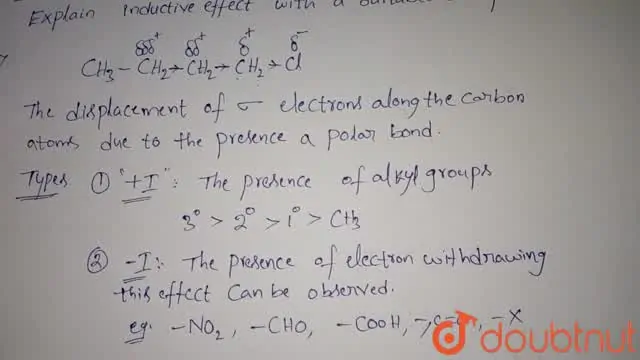Explain inductive effect with a suitable example.Solution in Telugu
Consider,the molecule CH3−CH2−CH2−Cl. There is a σ bond between 'C' atom and 'Cl' atom. The electron pair between them is not equally shared. The more electro −ve 'Cl' atom tends to attract the shared pair more towards itself. Due to this, the electron density tends to the greater near the 'Cl' atom than C atom. It is represented as −C−−)Cl. But carbon atom bounded to chlorine atom is itself attached to ther carbon atoms. Therefore the effect can be transmitted further.

The effect of the 'Cl' atom is to leave C1 slightly electron deficient. C1 in turn tries to rectify this by approprlating slightly more than its share of electron of the σ bond joining it to C2 and this continues down the carbon chain. However, the effect of C1 on C2 is less than the effect of Cl on C1 and the transmission quickly falls down away in a saturated chain and is generally too small to be noticeable beyond C3. These influences on the electron distribution in σ bonds are known as inductive effects.
Thus, inductive effect can be defined as ''The electron - donating or electron - with - drawing effect of an atom or group of atoms that is transmitted by the polarisation of electrons in σ bonds''.
Inductive effect is a measure of the ability of substituents to either withdraw or donate electron density of the attaced carbon atom. Based on this ability. The substituents are classified as electron - withdrawing orelectron - donating groups relative to hydrogen. Electron - withdrawing groups are said to exhibit −ve inductive effect (−I) and electron - donating groups are said to exhibit +ve inductive effect (+I).
Inductive effect influences chemical reactivity and physical properties.
Related Playlists
- BOOK - VGS PUBLICATION-BRILLIANTCHAPTER - ORGANIC CHEMISTRYEXERCISE - Short Answer Questions17videos
ORGANIC CHEMISTRY
- BOOK - VGS PUBLICATION-BRILLIANTCHAPTER - MOST IMPORTANT QUESTIONSEXERCISE - ORGANIC CHEMISTRY (LONG ANSWER TYPE QUESTIONS)11videos
MOST IMPORTANT QUESTIONS
- BOOK - VGS PUBLICATION-BRILLIANTCHAPTER - STATES OF MATTER : GASES AND LIQUIDSEXERCISE - ADDITIONAL QUESTION & ANSWERS10videos
STATES OF MATTER : GASES AND LIQUIDS
Similar Questions
Complete the following reactions and name the products A,B and C.
CaC2H2O−−→Ahot metal tube−−−−−−−−→BAlCl3+CH3Cl−−−−−−−−→C06:20View SolutionExplain Wurtz - Fitting reaction
06:09View SolutionA balloon is filled with hydrogen at room temperature. It will burst if pressure exceeds 0.2 bar, If at 1 bar pressure the gas occupies 2.27 L volume, upto what volume can the balloon be expanded?
09:14View Solutionउपयुक्त उदाहरणों सहित एक प्रक्रम की स्वतः प्रवर्तिता पर ताप के प्रभाव की व्याख्या कीजिए ।
View Solution+I तथा −I - प्रभावों से क्या अभिप्राय है तथा ये किस प्रकार के यौगिकों द्वारा दर्शाये जाते है? उपयुक्त उदाहरणों की सहायता से स्पष्ट कजिए। प्रेरणिक प्रभाव के मुख्य अभिलक्षों का भी वर्णन कीजिए ।
View Solutionफिनॉल्स की अम्लीय पर प्रतिस्थापियों का क्या प्रभाव पड़ता है? उपयुक्त उदाहरणों सहित व्याख्या कीजिए।
03:20View SolutionExplain inductive effect with suitable example
03:29View SolutionExplain inductive effect with suitable example.
04:07View SolutionExplain inert pair effect with suitable example.
07:12View SolutionWhat is inert pair effect ?
View SolutionExplain inert pair effect with suitable example.
View SolutionHow is inductive effect useful to explain the relative strength of aliphatic carboxylic acids? Explain with suitable examples.
03:06View SolutionWrite effect of concentration change on equilibrium and explain by suitable example.
View SolutionExplain effect of pressure change on equilibrium system by suitable examples.
01:52View SolutionExplain co-effectiveness with suitable examples.
03:42View Solution


